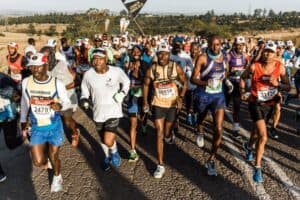Training tips from nine-time Comrades winner Bruce Fordyce.

The Comrades Marathon is a race deep and rich in tradition.
Some of these traditions are historic, like the green number, the different medals and the leading male runner carrying the mayoral baton.
Many are stirring and motivating, like the playing of Chariots of Fire and Shosholoza at the start.
Some are landmarks, like Arthur’s Seat and The Wall of Honour, while some are seemingly brutal and cruel, like the
cut-off points along the route and the final cut-off gun.
Some are quite strange and puzzling to the uninformed, like Max Trimborn’s cockerel crow and the playing of the Last
Post, but the most puzzling Comrades tradition must be that the distance markers along the route are placed in reverse order.
Yes, all 87 stones of the up run are placed in descending order along the route.
Everywhere else in the world race organisers know how to motivate runners.
The starting gun fires and you run for a while before passing a distance maker with “one” emblazoned on it.
If it’s a South African race it will be a kilometre marker, if a race like the New York or London marathons the marker
will take a little longer as it will be measured in miles.
But the point is, the distance marker will be a small motivation and an incentive to carry on to the next marker.
But in the Comrades the distance markers are placed in reverse order almost as if deliberately designed to demotivate,
terrify and depress runners.
If the first distance marker is visible in the dawn light on the Berea on June 9, it will indicate 86km to go!
Hours later runners will pass one stating 67km to go.
What does that mean other than there’s an awfully long way to go?
I remember running in a large leading bunch speeding along Harrison Flats in the 1982 Comrades Marathon.
As we passed the 56km-to-go distance marker, Alan Robb wickedly reminded us, “We’re on the starting line of the Two Oceans, guys.”
Suddenly our group lost several runners as the enormity of the task ahead dawned on us.
Alan chuckled as we continued to run.
He knew his comments would get rid of a few competitors.
At a Comrades talk that I attended as a raw novice many years ago, Alan told us that he coped with the reverse order distance markers by ignoring them.
He told us that he always viewed the Comrades challenge as four simple 20km training runs, followed by a furious 10km sprint to the finish line.
I could never quite see the Comrades in such simple terms but during the early stages of the Comrades I tried to ignore the distance markers.
I preferred to run the race from one famous landmark to the next.
So, on the up run, I would target the five major registered hills as long-term goals while on the journey from one major hill to the next, I would tick off famous landmarks.
The five registered major hills are, of course Cowies Hill, Fields Hill, Botha’s Hill, Inchanga and Polly Shortts.
If I were able to influence Comrades historians, I would argue a strong case for recognising seven registered hills on
the up run.
I firmly believe the third hill, outside Camperdown, and Little Pollies (Ashburton), should join the pantheon of registered hills.
The hill outside Camperdown is 750m long and very steep.
It comes as a nasty shock to many runners.
And there is nothing “little” about Little Pollies.
If it weren’t for the slight break in the climb a third of the way up, it would be every bit as tough as Polly Shortts itself.
While the distance between Little Pollies and Polly Shortts is only about a kilometre or so, the gaps between some of the other registered hills are big so then I would target various well-known landmarks as well.
On the journey from Botha’s Hill to Inchanga, I would tick off Kearsney College, the Wall of Honour, Arthur’s Seat
and Drummond Village.
Turning a blind eye to the distance markers, I made each landmark a reason to give a silent triumphant air punch.
“Another one bites the dust,” I would mutter to myself.
I believe that runners should only start to rely on the distance markers with about 21km to go.
A half marathon is familiar territory
for all of us.
While it is still a long way to go, it is a challenge that runners can understand, unlike the mind-boggling concept of 67km to go.
There will inevitably always be some wag who will shout out, “Half marathon to go, guys. We’re nearly there!”
But I suppose, relatively speaking, in an 87km race a half marathon to go is nearly there.
Before long there are just 10km to run, though the monster Polly Shortts will be just around the corner at that point.
Even that infamous hill can be broken down into its component parts.
There’s the first steep, curling bend to the left, then the long straight spine where it is possible to tick lampposts, one at a time, and then finally the last “S” bend to the top where every runner is allowed a massive air punch.
All this serves to emphasise that the most important step any runner can take is not a running step but a
decision to drive over the whole route before raceday.
After all it has been two years since the last up run and much of the race will have been forgotten.
It is invaluable to know what challenges lie ahead, to inspect the major registered hills and take note of the landmarks while trying to ignore freshly painted distance markers.
For more sport your way, download The Citizen’s app for iOS and Android.






